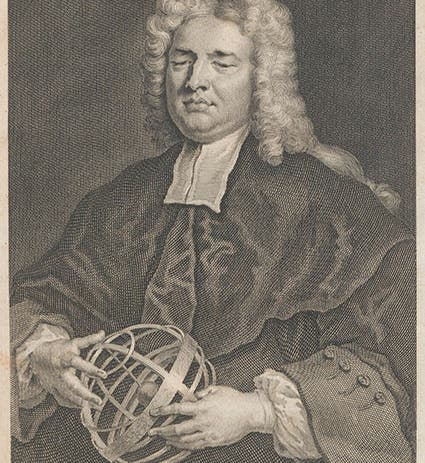Scientist of the Day - Nicholas Saunderson
Nicholas Saunderson, a British mathematician, died Apr. 19, 1739, at age 56 or 57. Saunderson was born in Peniston, West Yorkshire, and when he was just one year old, he came down with smallpox and was blinded. He was left not only sightless but eyeless, as a subsequent infection destroyed his eyes. Fortunately, his parents were supportive, and Nicholas learned to read, and was educated in the classics by tutors and at the free school he attended. Then he discovered that he had a natural facility for calculation, and he turned toward mathematics.
While still a boy, he, or his father or tutor, built a counting board to aid in performing calculations. Made of wood, about 12 inches square, it was divided up into 100 squares by wooden strips, and each square had nine holes drilled into it, like a keypad (second image). Saunderson could insert a large peg in the central hole and then a smaller peg in one of the other eight holes, and in this manner, represent the numbers 1 to 10. He could thus write a ten-digit number across the board. By manipulating these pegs, he could do rapid and complicated additions, multiplications, and divisions (square roots he did in his head). This later came to be called “Palpable Arithmetic,” and a diagram of his board was pictured in The Elements of Algebra, published just after his death, along with an explanation of its use (second and fourth images).
In 1707, Saunderson went down to Christ’s College, Cambridge, where he never officially enrolled, but was welcomed by the fellows of the college and lodged there. His mathematical skill and understanding were apparently widely admired. Older than most students, he taught other students Newtonian mathematics, and became a prominent member of the Newtonian school that was arising at Cambridge (Isaac Newton himself had already departed for London).
Newton had held a professorship, the Lucasian chair, at Cambridge. He had inherited it from his teacher, Isaac Barrow, the first occupant of the Lucasian chair, and when Newton left, the professorship passed to William Whiston. When it was discovered in 1710 that Whiston was a unitarian, he was removed from the chair (Newton had also been a unitarian, but had done a better job of keeping that a secret), and the professorship was opened up again. Newton recommended a successor, but, surprisingly, Newton’s choice was passed over in favor of the young Saunderson, who became the fourth Lucasian professor of mathematics in 1711, at age 29. He would occupy the chair for the next 27 years.
As a research professor, Saunderson was a bust – he published no original papers during his tenure, in fact, he published hardly anything at all while he was alive. But as a teacher, he was sensational, spending all his daylight hours tutoring young men in the art of algebra and calculus. And because he managed all this while blind, he was a widely admired figure at Cambridge. Early on, in 1714, he was appointed to the Board of Longitude, which offered a sizeable award for the first successful method of determining longitude at sea (an award that would, much later, be won by John Harrison). The other members of the commission were Newton, John Flamsteed, John Keill, Edmond Halley, and Roger Cotes. Imagine being appointed to a committee with those five as the other members! Yet Saunderson seemed to take it all in stride.
Saunderson later taught physical science at Cambridge, in addition to mathematics, thus helping to spread Newtonianism throughout the university, and thence the kingdom. King George II conferred on Saunderson a Doctorate of Laws in 1728. In the early 1730s, after a serious illness, he decided to write up his lectures on algebra and fluxions (calculus) for publication. He did not quite make the deadline. He died on Apr. 19, 1739, of scurvy, of all things. Fortunately, his colleagues, and his successor in the Lucasian chair, John Colson, ensured that his manuscripts were completed, edited, and published. The Elements of Algebra appeared in 1740, in two volumes; all our images for this essay were taken from the first volume, including the portrait, which served as frontispiece. Saunderson’s Method of Fluxions was printed in 1751; we have a later (1756) edition of this book. Both works served as textbooks at Cambridge for many years.
Saunderson has long been an example of human triumph over adversity, much like his later successor as Lucasian Professor at Cambridge, Stephen Hawking.
William B. Ashworth, Jr., Consultant for the History of Science, Linda Hall Library and Associate Professor emeritus, Department of History, University of Missouri-Kansas City. Comments or corrections are welcome; please direct to ashworthw@umkc.edu.










